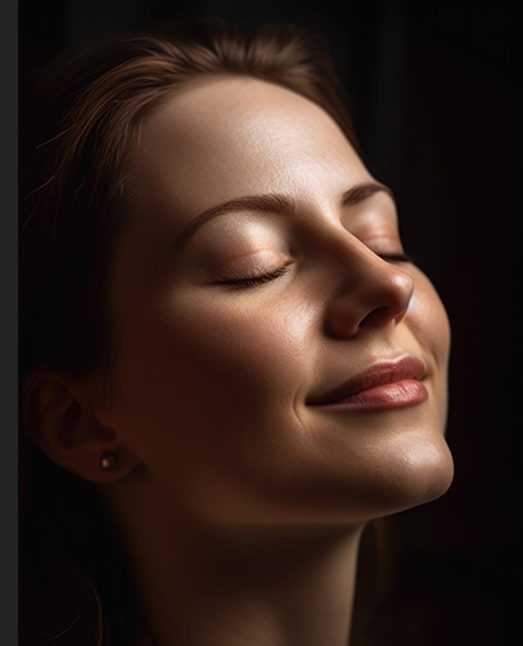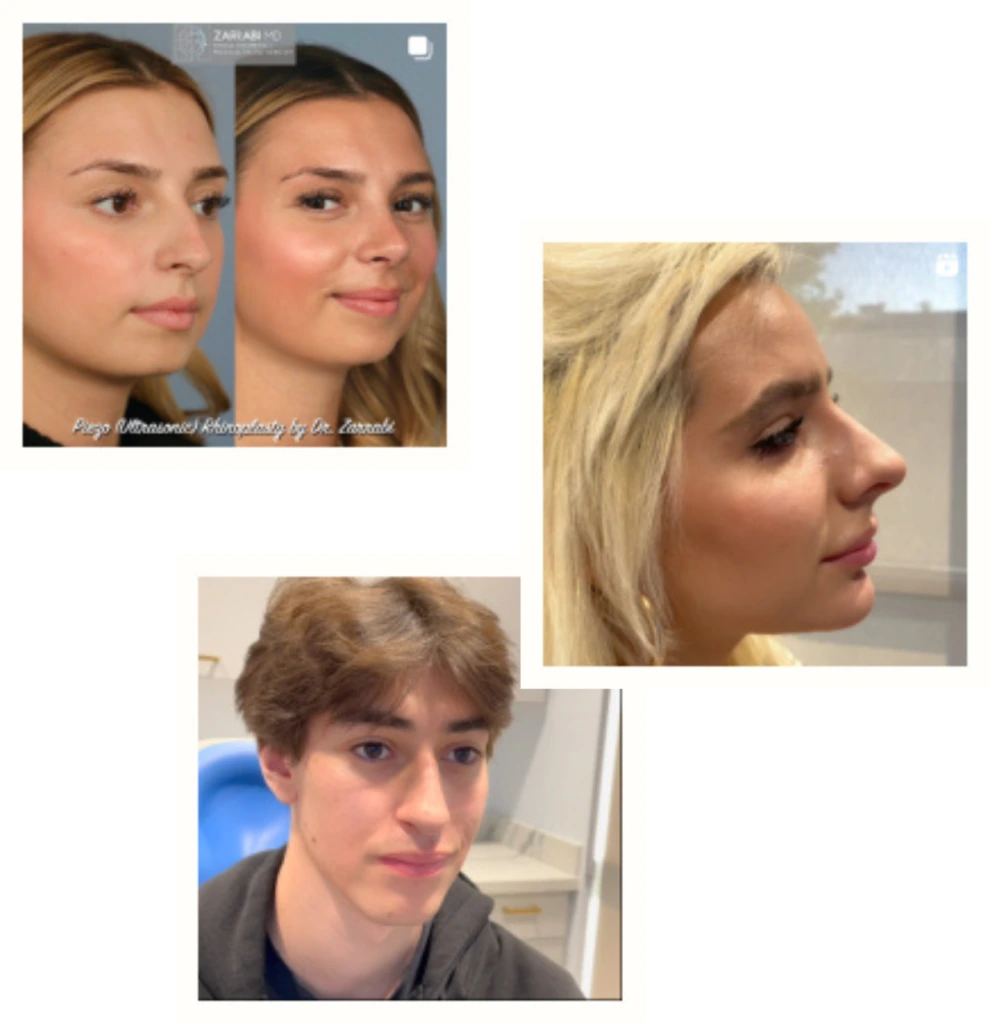What to expect from Ultrasonic Rhinoplasty Recovery?
What to expect from Ultrasonic Rhinoplasty Recovery?
What is Ultrasonic Rhinoplasty?
In nose surgery, ultrasonic rhinoplasty is a cutting-edge technique that reshapes the nasal bones for both aesthetic and functional purposes. Unlike traditional rhinoplasty techniques, which involve manually breaking and reshaping the nasal bone, ultrasonic rhinoplasty is a minimally invasive procedure.
This advanced procedure, including the piezo rhinoplasty offered at Zarrabi MD, employs ultrasonic technology to deliver results that are not only more precise but also less traumatic for the patient.
Preparing for Recovery after Ultrasonic rhinoplasty procedure
Discuss with your surgeon
Before the procedure, it’s crucial to have an in-depth consultation with your surgeon to discuss the surgical plan, which may include the use of minimally invasive procedures and specialized surgical techniques. This is the time to ask questions about how ultrasonic rhinoplasty differs from traditional methods in terms of tissue trauma and impact on surrounding tissue. Your surgeon will provide guidelines on what to expect during the recovery period, including potential side effects like swelling around the nasal tip or complications related to a deviated septum.
It’s also essential to discuss your expectations for reshaping the nose bone and any modifications to bone and cartilage. Understanding what this advanced surgical technique can and cannot achieve will help you set realistic and achievable goals, ultimately leading to higher satisfaction with the results. Your surgeon will outline the timeline for resuming normal activities and what to monitor for in terms of healing and potential complications.
Plan ahead for Your Post-Op Recovery Period
Medication and Supplies
Support and Environment
What to Expect from your Ultrasonic Rhinoplasty Recovery period

Immediate Ultrasonic rhinoplasty Post-Operative Care
Nasal Packing: Your surgeon may place nasal tubes to control bleeding and support the newly shaped nasal structure.
Facial Bruising and Swelling: It’s common to experience some facial bruising and swelling, particularly around the eyes and cheeks.
Monitoring: You’ll be closely monitored for any signs of complications after your nose surgery.
Pain Management
Prescribed Medication: There is a possibility that your surgeon will prescribe you oral pain medication to manage your discomfort. It’s essential to take these as directed.
Cold Compress: During the first 24 hours, applying a cold compress around the nose and eyes can help reduce swelling and alleviate pain. However, avoid direct contact with the nasal area.
Activity Restrictions
Bed Rest: You’ll be advised to rest for the first 24 hours and keep your head elevated to minimize swelling. Use pillows to prop yourself up, even while sleeping. After the first day, it is recommended to walk around the house for better blood circulation to help healing.
Limited Movement: Avoid any strenuous activities, including lifting heavy objects or bending over, as this can worsen swelling and prolong the healing process.
No Nose Blowing: Refrain from blowing your nose to avoid disrupting the surgical site and causing additional swelling or bleeding.
Hydration and Diet: Stick to soft foods and keep yourself hydrated, but avoid hot liquids as they can increase swelling.
Swelling and Bruising
Progressive Reduction: While you’ll still experience some swelling and bruising, you should notice a gradual reduction as the week progresses.
Dressing and Splint Removal
Scheduled Removal: A follow-up appointment is usually scheduled to remove any dressings, stitches, or splints within the first week. This is an essential step in assessing the initial results and ensuring proper healing.
Cleaning the Area: Your surgeon will likely provide guidelines on how to gently clean the nasal area after the dressing and splint are removed.
Returning to Work or School
Timeline: Most patients can return to work or school within 7-10 days post-surgery, depending on the nature of their job or activities. However, consult your surgeon for personalized advice.
Activity Level: While you may be able to resume normal activities, it’s important to steer clear of heavy lifting and intense physical exercise for at least a few more weeks to mitigate the risk of complications.
Appearance: Keep in mind that while significant swelling will have subsided, some minor swelling may still be present. Therefore, be prepared for some noticeable changes in your appearance when you return to your regular routine.


What Changes to Expect
Swelling Reduction: The majority of the swelling should continue to decrease, allowing you to see more of the final shape of your nose. The nose swelling will stay longer, around 6-12 months after the surgery, depending on the original shape of the nose.
Skin Sensitivity: You may notice changes in skin sensitivity around the nasal area, which is a normal part of the healing process.
Appearance: As swelling subsides, the refinements made to your nose will become more apparent, giving you a clearer idea of the surgical outcome.
Care Tips for Faster Recovery
Nasal Cleaning: Continue gently cleaning the nasal area per your surgeon’s guidelines, usually using a saline solution or prescribed ointment.
Moisturize: Keep the skin around the nose moisturized to help with dryness or irritation.
Avoid Sun Exposure: Protect your nose from exposure to direct sunlight, as the skin will be more sensitive and prone to sunburn.
Stay Hydrated: Proper hydration can aid in the healing process, so make sure to drink plenty of water.
Activity Guidelines
Light Exercise: You may be able to resume light exercise, such as walking, but consult your surgeon for personalized advice.
No Heavy Lifting: Continue to avoid strenuous activities and heavy lifting, as these can exacerbate swelling and slow down the healing process.
Social Activities: While you can likely return to social activities, be mindful of your healing nose, avoiding situations where it might be bumped or touched.
Work/School: If you haven’t already, you should be able to fully return to work or school, but be cautious about physical activities that could impact your nose.
Long-Term Recovery
When to Expect Final Results
Gradual Changes: While most of the swelling will have subsided within the first few months, minor changes can continue to occur for up to a year.
Final Appearance: The complete healing process can take up to a year, and that’s generally when you can expect to see the final, refined shape of your nose.
Photographic Progress: It’s a good idea to take periodic photos to track the progress and changes in your nose’s appearance over time.
Care Tips for Faster Recovery
Nasal Cleaning: Continue gently cleaning the nasal area per your surgeon’s guidelines, usually using a saline solution or prescribed ointment.
Moisturize: Keep the skin around the nose moisturized to help with dryness or irritation.
Avoid Sun Exposure: Protect your nose from exposure to direct sunlight, as the skin will be more sensitive and prone to sunburn.
Stay Hydrated: Proper hydration can aid in the healing process, so make sure to drink plenty of water.
Activity Guidelines
Light Exercise: You may be able to resume light exercise, such as walking, but consult your surgeon for personalized advice.
No Heavy Lifting: Continue to avoid strenuous activities and heavy lifting, as these can exacerbate swelling and slow down the healing process.
Social Activities: While you can likely return to social activities, be mindful of your healing nose, avoiding situations where it might be bumped or touched.
Work/School: If you haven’t already, you should be able to fully return to work or school, but be cautious about physical activities that could impact your nose.








Guidelines for Ultrasonic Rhinoplasty Recovery
Recovering from an Ultrasonic Rhinoplasty requires careful attention to post-operative care. To help you navigate this crucial period, here are some straightforward guidelines on what to do and avoid for a successful recovery.

What To Do
Adhere to Your Surgeon’s Guidelines for Post-Surgery Care:
Your surgeon will offer personalized guidelines that are customized to meet your requirements. Following these guidelines is crucial for optimal healing and achieving the best results.
Elevate Your Head to Minimize Swelling: Keeping your head elevated, even while sleeping, can help reduce swelling and speed up healing.
Utilize Ice Packs to Alleviate Inflammation: Applying ice packs around the nose and eye area can help minimize swelling and alleviate discomfort. However, avoid direct contact with the nasal area to prevent complications.
What To Avoid
Refrain from Engaging in High-Intensity Activities: Strenuous exercise and heavy lifting can exacerbate swelling and prolong the healing process. Consult your surgeon before resuming such activities.
Avoid Blowing Your Nose: Blowing your nose can disrupt the surgical site and cause additional swelling or bleeding. Use tissues gently if needed, and consult your surgeon for specific guidelines.
Steer Clear of Exposing the Operated Area to Direct Sunlight: After surgery, your skin will be more sensitive, and direct sun exposure can lead to sunburn and slow down the healing process. Always use sunscreen or wear a hat when outdoors.
Tips for a Smooth Recovery







Conclusion
The ultrasonic rhinoplasty recovery is a layered experience, encompassing immediate post-surgery care and long-term healing milestones. Patients should anticipate initial symptoms like pain, swelling, and bruising, which will progressively diminish in the weeks post-surgery. Strict compliance with your surgeon’s post-operative instructions, including guidelines for managing pain and limiting activities, is vital for a successful recovery. It’s especially beneficial to consult a board-certified maxillofacial surgeon like Dr. Shahrouz Zarrabi of Zarrabi MD for expert guidance. Utilizing aids such as ice packs and saline sprays can facilitate healing, and attention to lifestyle choices and emotional health is equally important.
While complications are generally uncommon, they demand prompt intervention and could prolong the overall recovery period. Scheduled follow-up visits with your surgeon are crucial for tracking your healing progress and addressing any concerns or necessary adjustments.
In essence, being well-informed about the recovery process and actively participating in your own care can significantly influence the ultimate success of your ultrasonic rhinoplasty. Consult your surgeon for personalized guidance tailored to your individual needs.
Follow us on Instagram









